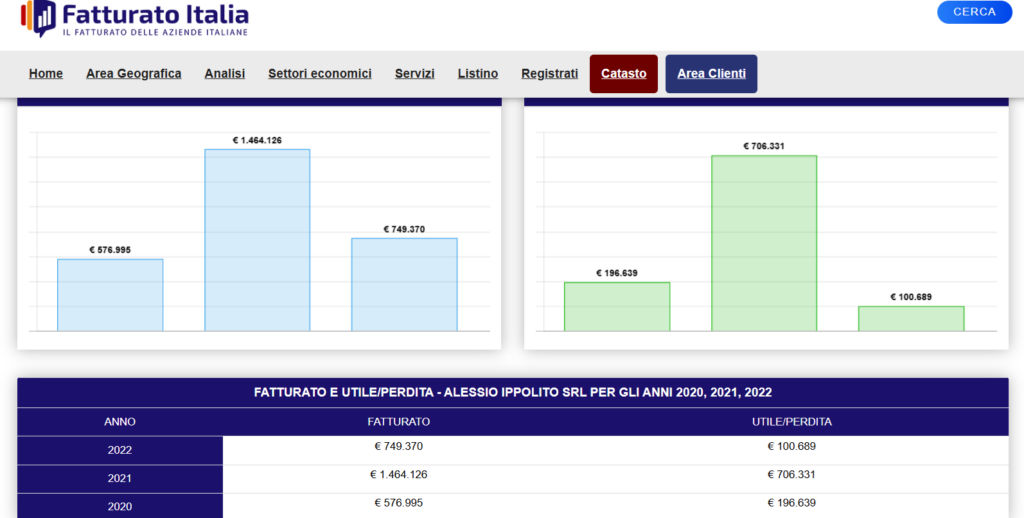
Mi chiamo Alessio Ippolito, sono nato il 9 agosto 1984 nella ridente cittadina di Frascati (Roma), situata nel cuore nevralgico dei castelli romani. Sono un imprenditore digitale attivo dal 2008, autore e giornalista finanziario dal 2022 iscritto presso l’OdG del Lazio[1].
Ho iniziato a muovere i primissimi passi nel mondo digitale nel lontano 2008, anno in cui ho lanciato il mio primo sito web, realizzato completamente da me: era un semplicissimo blog di natura economica, all’interno del quale pubblicavo approfondimenti e pillole finanziarie frutto dei miei appunti presi durante le mie lezioni di micro e macroeconomia all’Università la Sapienza di Roma.
Studi e formazione
Diplomato con ottimo punteggio all’ITCG Luzzatti di Palestrina (RM), l’anno seguente mi sono iscritto presso la prima Facoltà di Roma, con indirizzo Economia e Finanze per la Gestione d’Impresa[2], non terminando però gli studi in quanto – pur appassionandomi diverse materie – ritenevo che stessi, in un certo senso, perdendo del tempo utile per studiare ciò che amavo realmente fare: migliorare le mie conoscenze nel campo del web marketing al fine di autoprodurmi siti informativi di ottima qualità e molto trafficati, avviando così uno o più business di successo.
Così dal 2009 ho iniziato a studiare, letteralmente giorno e notte, ogni aspetto propriamente relativo al mondo del business digitale, dell’editoria web e delle affiliazioni, seguendo i più disparati corsi online e seminari, frequentando forum (soprattutto quello di Giorgio Taverniti – Giorgiotave – e di Paolo Moro – Alverde.net – si, il mio nick era “Tradingforex“), divorando libri di settore sia in lingua italiana che inglese, e partecipando per anni – in modo attivo – a numerosi gruppi su Facebook.
Storia professionale, carriera e il successo
Cerco di riassumere alcuni dei fatti più salienti, cercando di essere estremamente sintetico.
Dopo diversi anni di studio/lavoro come libero professionista intrapresi tra il 2008 e il 2011, nel 2012 ho fondato la mia primissima azienda, era una semplice ditta individuale il cui nome: “Ditta Individuale di Alessio Ippolito” (ho sempre avuto tanta inventiva nella scelta dei nomi delle mie aziende eh), che due anni più tardi l’ho trasformata in una Società in Accomandita Semplice (ALESSIO IPPOLITO S.A.S.).
Considerata la crescita anche della SAS, nel 2017 – insieme al mio studio commercialista – abbiamo deciso di fare un ennesimo passo in avanti, realizzando uno dei miei sogni: creare una società di capitali a mio nome e totalmente da me gestita, quella che è ad oggi la mia più grande soddisfazione e motivo di orgoglio, la Alessio Ippolito S.R.L. Editore. Questa società è proprietaria di un network di 6 siti web principali, tra cui le note pubblicazioni online come Criptovaluta.it® e TradingOnline.com®. Guarda qui il mio network.
Il 2017 è stata una data particolarmente “fortunata” per il prosieguo della mia carriera imprenditoriale: fu l’anno nel quale acquistai il dominio Criptovaluta.it, il cui sviluppo fu completato pochi mesi più tardi. Nel 2018 il sito andò definitivamente online, con un’ambizione ben definitiva: diventare il punto di riferimento in Italia nel panorama crypto.
Autore di Criptovaluta.it®
Criptovaluta.it è nata come blog, dopo pochi mesi è entrata a far parte delle fonti di notizie in Google News. Dopo due soli anni di “gavetta“, nel 2020 decisi di dare una spinta al sito, focalizzando su di esso tutti i miei sforzi economici, imprenditoriali, di ricerca e sviluppo. Il primo grande boom di traffico arrivò nel 2021. Nel corso degli anni si è imposto come crypto news media outlet leader italiano, consolidando la sua posizione di leadership, misurabile sia in termini di autorevolezza ed influenza mediatica nel settore, sia utilizzando diversi parametri di analisi delle performance come Similarweb, Google Search console e Google Analitycs.
Risorse utili:
Storia della crescita di Criptovaluta.it®
Come si legge sul sito:
Il boom di Criptovaluta.it nel 2021 è stato evidente. Siamo il sito sulle criptovalute più seguito in Italia.
Marzo 2021: Sessioni del mese 542.000
Aprile 2021: Circa 1.000.000 di sessioni, quindi il doppio rispetto al mese precedente.
Totale 1° QUADRIMESTRE: 2.000.000 sessioni circa
Confronto 1° QUADRIMESTRE 2021 con 1° QUADRIMESTRE 2020: 2.000.0000 sessioni circa VS 72.200 per una crescita complessiva di sessioni pari a 2.451,51%.
Nel maggio del 2021 Criptovaluta.it raggiunge il suo record storico di visite: 1.400.000+ accessi in un mese, diventando così il primo sito tematico sulle criptovalute più letto in Italia. Tradotto in termini percentuali, la crescita del sito è stata di +50% rispetto al mese di Aprile 2021, e addirittura del 8.157,34% rispetto ad un anno fa (Maggio 2020).
Secondo semestre 2021: 9 milioni di accessi complessivi. In termini di percentuali, significa una crescita dell’8.400% rispetto al semestre del 2020.
Criptovaluta.it® diventa marchio registrato
Il 15 dicembre 2021 la ALESSIO IPPOLITO S.R.L. ha depositato il marchio presso il MiSE (Ministero per lo Sviluppo Economico) per proteggerne integralmente tutte le sue attività, il suo business, difendendone i diritti d’autore. La registrazione effettiva del marchio è avvenuta il 5 settembre 2022[5].

Criptovaluta.it® diventa testata giornalistica
Sulle ali dell’entusiasmo, al fine di dare ancora una maggiore credibilità a quello che in realtà era ancora un semplice blog amatoriale, intrapresi dai primissimi giorni del 2022 una lunga ed estenuante rincorsa alla registrazione del blog a Testata Giornalistica iscritta presso un autorevole Tribunale italiano. Ci provai 3 volte: Tivoli, Roma e poi Milano e, dopo mesi e mesi di snervanti pratiche burocratiche, carte su carte e salate parcelle pagate ai rispettivi professionisti, precisamente il 10 ottobre 2022, finalmente Criptovaluta.it® diventa ufficialmente una testata giornalistica iscritta presso il Tribunale di Milano col numero 12776/2022 – Num. Reg. Stampa: 143[6] – esattamente un mese e mezzo dopo la registrazione del marchio.
Criptovaluta.it® recensioni e testimonianze
La mia idea riguardo la condivisione di opinioni e recensioni di un prodotto online è piuttosto semplice: alle parole devono esser susseguiti i fatti. Si può essere autorevoli e popolari quanto vogliamo ma se non lo dimostriamo con i numeri, il tutto resta vano, specie se il tuo target è l’utenza online.
La nostra testata di riferimento riceve molti consensi online, che si traducono in feedback dei lettori che seguono le nostre news ed approfondimenti sul sito e sui nostri social (soprattutto Telegram sia per il canale pubblico che per quello PREMIUM VIP a pagamento, ndr). Riceviamo feedback principalmente su Google e TrustPilot, qui sotto potete trovare un piccolo esempio:
TrustPilot
I nostri lettori amano condividere l’esperienza informativa vissuta sulle nostre pagine anche su Trustpilot e non ci nascondiamo dietro ad un dito: per la ALESSIO IPPOLITO S.R.L. e per tutto lo staff che lavora notte e giorno su Criptovaluta.it, è motivo di forte orgoglio: qui puoi visitare il TrustPilot di Criptovaluta.it.

Il successo di Criptovaluta.it®
Con una media su anno di oltre 2.000.000 unici mensili e 3.500.000 milioni di pagine viste al mese, mezzo milione di followers attivi sui social e circa 2.7 milioni di commenti al mese presenti sulla nostra community Telegram, Criptovaluta.it è riconosciuta dall’unanimità degli addetti ai lavori del mercato crypto in Italia, come il media leader del settore, sia in termini di qualità dei contenuti, tempismo nella pubblicazione delle notizie, esclusività ed espressione dei concetti anche più complessi.
Le principali testate giornalistiche americane come TheBlock e Decrypt, parlando della testata da me diretta, la definiscono come “most important crypto news media outlet in Italy“. Riprese giornalistiche, contatti istituzionali (vedasi ns esclusive con i protagonisti del Parlamento Italiano), interviste TV, menzioni delle più autorevoli testate nazionali, citazioni televisive, confermano l’autorevolezza di questo marchio. Puoi approfondire questo argomento dando uno sguardo alla pagina parlano di me.
Alessio Ippolito libri
Su Google Books puoi prendere visione e scaricare le mie pubblicazioni. I miei libri sono rivolti a tutti coloro che sono interessati al mondo dell’imprenditoria, del giornalismo e del futuro digitale con un occhio di riguardo all’intelligenza artificiale e le sue implicazioni.
Alessio Ippolito su Google: cosa dice di me
Paragrafo in fase di sviluppo.
Gli altri progetti digitali di successo da me realizzati partendo da zero
Oltre ad essere il direttore responsabile di Criptovaluta.it, sono anche il direttore di altri marchi prestigiosi, primo fra tutti TradingOnline.com®, il principale quotidiano finanziario sul trading online in Italia. Sono poi anche direttore di un sito web di nicchia e storico sul trading online in Italia chiamato GuidaTradingOnline.net, e gestisco siti estremamente verticali dedicati agli investimenti in borsa online come Investireinborsa.org e Giocareinborsa.net.
Infine, a novembre 2024, ho lanciato anche un sito news sviluppato su un dominio storico .it LLL (3 lettere, ormai introvabile tipologia di domini, ndr) e si chiama Gex.it: questo sito si occupa di pubblicare ogni giorno le ultimissime notizie dal mondo delle nuove tecnologie, l’intelligenza artificiale, il deep tech e la Web3.
Qui puoi consultare il network della ALESSIO IPPOLITO S.R.L. editore.
Il mio impiego professionale sui principali portali informativi del network
Direttore di Criptovaluta.it®: Dal 2017, anno della sua nascita, sono il direttore responsabile a tempo pieno di Criptovaluta.it, la più seguita testata giornalistica italiana verticale su Bitcoin e crypto, di respiro internazionale, con riconoscimenti e menzioni TV, radiofoniche e dal mainstream internazionale. Testate crypto USA blasonate come TheBlock o Decrypt ci definiscono come il principale “crypto news media outlet italiano”. Con oltre 30 milioni di lettori negli ultimi due anni e una community tra le più influenti del settore.
Ogni settimana su Criptovaluta.it vengono pubblicate +100 articoli tra news, analisi, esclusive, interviste e approfondimenti legati al mondo crypto, osservando particolare attenzione ai principali focus del momento. Può vantare di menzioni e riconoscimenti internazionali, interviste ai tutti i più grandi personaggi influenti del settore, citazioni ed apparizioni radiofoniche e televisive.
Criptovaluta.it è un marchio registrato di proprietà della Alessio Ippolito S.R.L.
Direttore di Guidatradingonline.net: Dall’ottobre del 2016 a giugno del 2020 sono stato collaboratore esterno a tempo pieno per lo sviluppo di www.guidatradingonline.net, chiamato dal fondatore Antonio Loverato – per il quale ho curato, insieme al lui, il lancio e tutta la fase di creazione della struttura contenutistico. Guidatradingonline.net è un sito verticale esclusivamente dedicato a 360° sul mondo del #tradingonline. Offre guide complete dedicate allo studio e alla formazione di principianti che vogliono scoprire o approfondire il mondo degli investimenti finanziari.
Ad aprile 2019 la ALESSIO IPPOLITO S.R.L. ha acquisito il portale e sono diventato il direttore generale a tempo pieno.
Dal 30 gennaio 2025 ho assunto un ruolo manageriale completo su Guidatradingonline.net per sviluppare ulteriormente il suo brand dopo aver ottimizzato tutta la parte front-end del sito, iniziata verso fine 2023. Questo giornale è stato considerato per anni il punto di riferimento sulla ricerca organica di Google.it per tutti coloro che vogliono iniziare a muovere i primissimi passi con il trading online partendo da zero.
Per la ALESSIO IPPOLITO S.R.L. Guidatradingonline.net rappresenta da anni un caposaldo del suo network SEO verticale sul trading.
La società conversa ottime aspettative di crescita di questa testata di approfondimento e il mio ruolo sarà proprio quello di riuscire ad ottenere gli obiettivi prefissati in sede decisionale, con strategie operative e di marketing appositamente studiate.
Direttore di Investireinborsa.org: Sono direttore generale a tempo pieno da febbraio 2024, mentre da dicembre 2024 ricopro su Investireinborsa.org anche la posizione di brand developer, con l’obiettivo di migliorare visibilità, posizionamento strategico e percezione del brand Investireinborsa.org online.
Direttore di Giocareinborsa.net: Da giugno 2024 la ALESSIO IPPOLITO SRL ha assorbito il brand Giocareinborsa.net a giugno 2024. Per questo sito mi occupo di gestire lo sviluppo strategico-editoriale nonchè migliorare la percezione del marchio sui motori di ricerca.
Direttore di TradingOnline.com®: Da dicembre 2020 sono proprietario e direttore responsabile di TradingOnline.com, il il sito ufficiale sul #tradingonline attualmente disponibile in italiano. News, guide ed approfondimenti relativi al trading, azioni, forex, crypto, obbligazioni e principali assets di borsa.
Direttore di GEX.it NEWS: Da novembre 2024, data di messa online del progetto, mi occupo dello sviluppo strategico del brand, del project management e di tutto ciò che riguarda la comunicazione, firmandone editorialmente tutte le principali notizie dedicate al mondo della tecnologia e della Web3. Gex.it è un prodotto della ALESSIO IPPOLITO S.R.L. Editore.
Puoi approfondire più nel dettaglio i miei ruoli assunti nel corso del tempo sui vari siti web, visitando il mio profilo Linkedin.
La mia iscrizione presso l’Ordine dei Giornalisti del Lazio
Sono giornalista iscritto all’Ordine dei Giornalisti del Lazio[6] dal 22 febbraio 2022 (Elenco Speciale – Giornalisti Tecnici Specializzati). L’iscrizione all’elenco speciale dei giornalisti è destinata ai professionisti che presentano domanda per conto di un editore di un quotidiano online per essere registrati come Testata giornalistica presso un tribunale (tali richieste sono soggette a verifica e potrebbero essere respinte).

La credibilità acquisita dal giornale Criptovaluta.it nel 2021 ha spinto la mia azienda – proprietaria del sito – a registrare prima il marchio e, poco dopo, a presentare domanda al Tribunale di Milano per la registrazione come testata giornalistica.
Iscrizione come Operatori della Comunicazione (R.O.C)
Sempre sul finire del 2022 abbiamo presentato domanda di iscrizione della ALESSIO IPPOLITO S.R.L. Editore presso Agcom.it, per essere registrati al R.O.C., il Registro degli Operatori della Comunicazione.

Come si legge sul portale Criptovaluta.it:
In data 27 ottobre 2022 la società proprietaria di Criptovaluta.it, è registrata al ROC della Lombardia, con numero di registrazione 38686[7].
Codice LEI aziendale
Essendo la nostra azienda attiva in campo finanziario e candidata alla compravendita di assets finanziari, siamo dovuti – secondo quanto richiede la legge – ad essere iscritti presso il LEI:
Il codice LEI è obbligatorio per le entità giuridiche che effettuano transazioni di strumenti finanziari (come compravendita di azioni, obbligazioni, warrant, titoli di stato e derivati). In caso di operazioni nei mercati finanziari il codice LEI è obbligatorio per: soggetti iscritti al Registro Imprese, filiali italiane di società estere, fondi di investimento gestiti da società iscritte al Registro Imprese, fondi pensione italiani, altri enti (come Pubbliche Amministrazioni, Associazioni, Fondazioni). Fonte: Infocamere.it
Volendolo spiegare in parole semplici il codice LEI è un lungo codice alfanumerico (questo il nostro: 98450055C12DDBF13778, che puoi visualizzare su Bloomberg) che serve ad identificare in modo facile e veloce gli operatori che compravendono strumenti finanziari e che sono tenuti ad obblighi di reporting alle istituzioni.
Qui i dettagli della nostra iscrizione attiva.
Mindset e principi imprenditoriali
Sempre alla ricerca di innovazione, in particolare dal mondo del web e delle nuove tecnologie, sono costantemente interessato a esplorare nuove opportunità di investimento in startup e idee imprenditoriali.
Tutti i miei brand di maggiore successo sul web sono sempre partiti con la stessa logica operativa:
- Nasce l’idea;
- La studio ed approfondisco al fine di comprenderne la fattibilità;
- Inizio a raccogliere il materiale e tutte le risorse utili per studiare ed approfondire il progetto;
- Eseguo una prima analisi dei costi iniziali, quindi predispongo il budget;
- Pianifico il team di sviluppo;
- Metto in pratica l’idea, dandole forma e vita;
- La mia idea è diventata realtà.
Ma, cosa ancora più importante, è crederci dal primo istante, fissare il target e massimizzarne il focus: senza cuore e mente ogni iniziativa imprenditoriale diventa vana.
Proposte commerciali ALESSIO IPPOLITO S.R.L.
Se vuoi candidarti per collaborare in modo sinergico e proattivo con uno o più brand del mio network, inviami una proposta commerciale compilando il modulo che trovi qui sotto:
Sede aziendale
Via Pola 11
20124 Milano, Italy
P.IVA 14569041008
R.O.C. 38686 del 27/10/2022
LEI 98450055C12DDBF1377
Quanto guadagno? ALESSIO IPPOLITO S.R.L. fatturato
Stando alle ricerche su Google, se lo chiedono in molti. Sono il founder della mia società – la ALESSIO IPPOLITO S.R.L. – quindi il mio guadagno dipende essenzialmente dalle performance, misurabili in termine di utile, ottenuti annualmente dalla mia azienda.
Essendo una S.R.L. i bilanci sono pubblici, quindi i risultati possono essere facilmente consultati online. Di seguito un’analisi del trend di bilancio della mia azienda prodotto da Fatturato Italia[4]:

La mia gestione del tempo
Dio solo sa, permettetemi una battuta prima di concludere, quanto tempo ha a sua disposizione un imprenditore, specie se digitale 🙂 davvero tanto, a tal punto che… magari alle due di notte si trova a dover mandare un task all’assistenza perchè un suo sito è sotto attacco hacker, a fare preventivi argomentandoli con 3.000 parole (almeno) ad una multinazionale israeliana perchè loro “o ti sbrighi o da domani non ti prendono più in considerazione“, oppure il primo maggio deve correre davanti al PC perchè ti ha scritto una multinazionale finance chiedendoti di risolvere alcune “compliance rules” entro e non oltre 24H, pena il blocco dei conti di affiliazione e di conseguenza i pagamenti.
Ovviamente tutti fatti realmente accaduti...
Ad ogni modo, dopo 17 anni di attività, potrei scrivere interi libri su questa tematica, tuttavia non è nel mio interesse tediarvi cagion di questo: con gli anni impari infatti a gestire meglio il tuo tempo, ritagliandoti del tempo libero per vivere una vita con la V maiuscola. Con l’esperienza impari a capire come quando e cosa delegare ai tuoi stimati collaboratori e ad ottimizzare meglio il tuo tempo lavorativo.
Passioni, hobby sport e… tempo libero
Quando parlo del mio lavoro e rispondo a conoscenti e fan sempre molto interessati alla mia professione, a volte mi chiedono anche: “e nel tempo libero che fai?“.
Concedetemi una battuta: perchè davvero ne resta?
Nel corso degli anni ho sicuramente imparato a gestire meglio il mio tempo, per ritagliarmi del tempo tutto per me, per le mie attività personali extra lavoro e, ovviamente, per le mie passioni: questo mi permette di garantirmi un buon stile di vita. Le mie passioni più grandi sono sicuramente la palestra, mantenimento e cura del mio aspetto fisico, la passione per i viaggi (oltre a quelli di lavoro, ndr), seguire lo sport in genere e soprattutto il calcio… la sregolata passione per l’AS Roma… non me ne vogliano ora i tifosi delle squadre avversarie 🙂
Amo anche cucinare piatti fit, leggere libri specialmente rivolti alla crescita personale, alla finanza e alla gestione d’impresa e approfondire i temi delle nuove tecnologie applicate al web, come l’innovazione dell’intelligenza artificiale e tutte le sue implicazioni, approfondendo varie risorse come libri, risorse universitarie, studi e, perchè no, anche video su Youtube.
Vita privata
Cosa volete sapere nello specifico? Tengo molto alla mia privacy, anche se chi mi conosce di persona magari non lo direbbe (si, sono normalmente un grande chiacchierone, per alcuni versi quasi logorroico 🙂 ), ma potete vedere qualche storia anche relativa a questo magari seguendomi sul mio profilo Instagram, dove comunque condivido anche storie duranti i miei viaggi personali e lavorati ma anche i miei hobby e le mie passioni.
I miei articoli su Linkedin
Sul mio profilo personale LinkedIn, puoi trovare post e analisi approfondite sui settori chiave di mio interesse (trading online, Bitcoin e criptovalute), nonché approfondimenti e riflessioni su editoria e giornalismo.
È naturale aspettarsi che gran parte dei miei contenuti pubblicati su LinkedIn siano strettamente correlati ai miei argomenti di maggior interesse: #Bitcoin #Crypto #giornalismo #editoria #impresa ed #imprenditoria.
Profilo professionale Crunchbase – Imprenditore
La mia attività – ALESSIO IPPOLITO S.R.L. – è regolarmente iscritta presso il sito Crunchbase, popolare sito internazionale dove milioni di professionisti condividono informazioni per accrescere il proprio business, puntando su risorse umane, ricerca, raccolta fondi e sviluppo.
E su Crunchbase, oltre alla mia azienda, sono anche registrato come imprenditore, con occupazione fissa presso quest’ultima.
